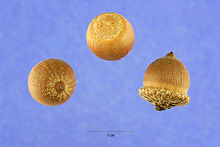Willow oak
| Willow oak | ||||||||||||
|---|---|---|---|---|---|---|---|---|---|---|---|---|

Willow oak ( Quercus phellos ), leaves |
||||||||||||
| Systematics | ||||||||||||
|
||||||||||||
| Scientific name | ||||||||||||
| Quercus phellos | ||||||||||||
| L. |
The willow oak ( Quercus phellos ), also called willow-leaved oak , is a deciduous tree from the oak genus that is native to North America . Their leaves are similar in shape to those of willow .
description
The willow oak grows as a deciduous tree ; in the southernmost part of its range it is almost evergreen. It reaches heights of growth up to about 30 meters, rarely above. It forms a dense, rounded treetop . The willow oak can reach a trunk diameter of 1 to 1.5 meters, but also up to 2 meters. The bark on the young tree is smooth and gray; it cracks with age; the inner bark that becomes visible between the cracks is light orange.
The twigs are thin and initially olive-brown, later red-brown. The terminal buds are maroon. The alternate leaves are elongated to lanceolate with a wedge-shaped base and tapering to a point. A small, almost hair-thin bristle sits on the tip of the leaf. The leaves are about 5 to 10 inches long, 2 cm wide and have entire margins. The leaves are dull yellow-green on top; on the underside they are initially hairy. The petiole is about 2 to 4 mm long. The young leaf shoots are initially yellow with a red center. The autumn color is pale yellow to brownish yellow.
The willow oak is monoecious . The flowering time falls in spring, roughly at the same time as the leaves shoot. The male flowers are in slender, pendulous yellow-green catkins . The female flowers are usually solitary, sometimes in pairs on a very short stem. The acorns ripen within two years. In the first year they are about 2 mm small and spherical. The ripe acorns, about 1 cm in size, are brown and sit in a flat cup that covers almost a third of the acorn. The overlapping scales that make up the cup are thin, hairy, and dark red in color.
The willow oak is relatively fast-growing when the site conditions are right.
Distribution and location
The home of the willow oak is in the southeastern United States . Its range consists of a western and an eastern part, which are connected to a contiguous area by a relatively narrow strip in Georgia . The western area extends from eastern Texas and southeastern Oklahoma through southeastern Missouri , Arkansas and Louisiana in an easterly direction via Mississippi , Alabama , Tennessee , the southernmost tip of Illinois and southern Kentucky to Georgia. From here the eastern part of the distribution area runs in a north-easterly direction via South Carolina , North Carolina and Virginia to Maryland , Delaware , New Jersey , New York and the District of Columbia .
Preferred locations for the willow oak are alluvial land and river valleys, although waterlogging locations are avoided. The willow oak prefers rather acidic soils; their natural range extends over altitudes from 0 to 400 m.
While the willow oak is planted relatively often in North America as an ornamental tree and providing shade, it is rarely seen in Central Europe .
use
The wood of the willow oak is used as construction wood or for wood pulp .
ecology
Many wild animals such as ducks , squirrels , deer , turkeys , blue jays and Melanerpes erythrocephalus ("red-headed woodpecker") feed the acorns .
Pests and diseases
The willow oak is very sensitive to fire. Even light fires kill seedlings. After forest fires, older trees have also died, and surviving specimens often wither until they finally die off due to invading fungal diseases.
A common pest on willow oaks is the Porling species Polyporus hispidus .
The most important insect pests include the bark beetle species Enaphalodes rufulus ("red oak borer"), Prionoxystus robiniae ("carpenterworm") and Goes pulverulentus ("living-beech borer").
Systematics
The first description by the Swedish botanist Carl von Linné was published in 1753.
There are no varieties within the species. The willow oak hybridizes with several other oak species; Crosses with the following species are proven:
- Quercus coccinea (WW Ashe 1894)
- Quercus ilicifolia : The hybrid is called Quercus × giffordi Trelease.
- Quercus incana (EJ Palmer 1948)
- Quercus marilandica
- Quercus nigra
- Quercus pagoda : The hybrid is called Q. × ludoviciana Sargent.
- Quercus palustris
- Quercus rubra
- Quercus shumardii
- Quercus velutina
According to DM Hunt (1989) it also hybridizes with the following other species:
literature
- Alan Mitchell, translated and edited by Gerd Krüssmann: The forest and park trees of Europe: An identification book for dendrologists and nature lovers . Paul Parey, Hamburg and Berlin 1975, ISBN 3-490-05918-2 .
Web links
- Entry at Flora of North America (English)
- Specifications at VirginiaTech (English)
- Entry with USDA ; there also data sheet (English)
- Description at na.fs.fed.us (English)
- Description at fcps.edu (English)
- Pictures at cas.vanderbilt.edu (English)
supporting documents
- ↑ Col. Pl. 2: 994 (1753). See entry at GRIN Taxonomy for Plants .
- ↑ See entry in Flora of North America.

